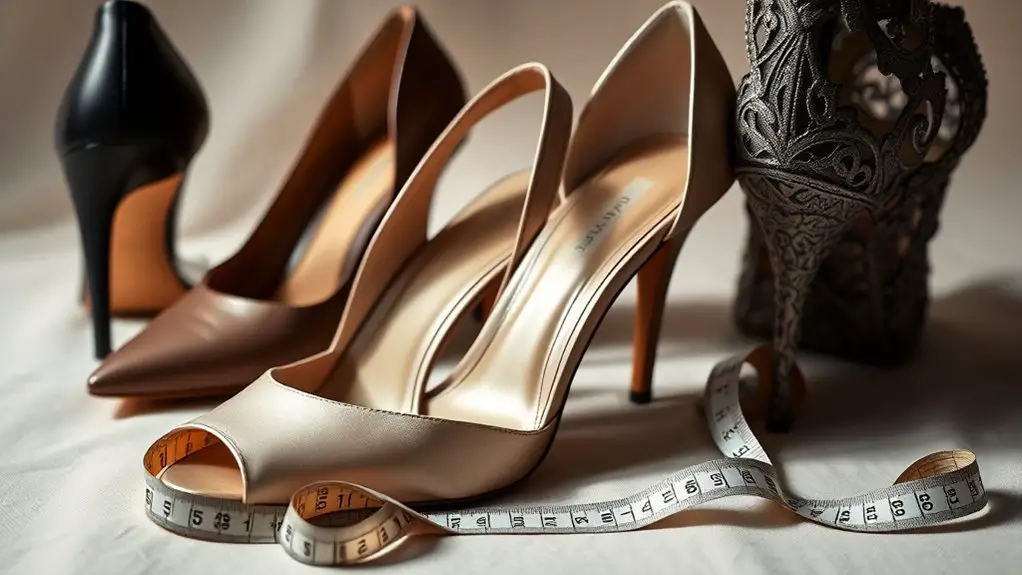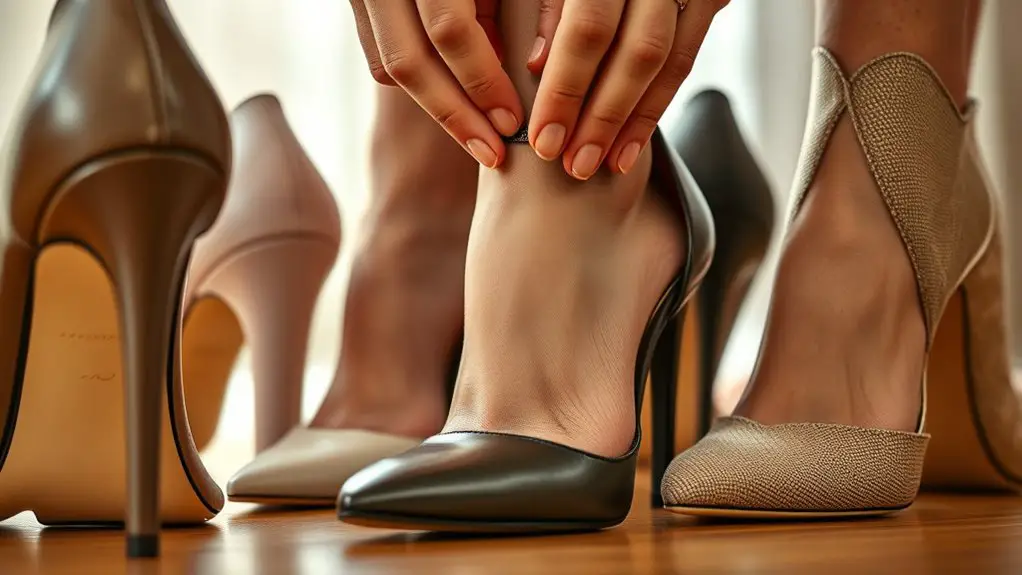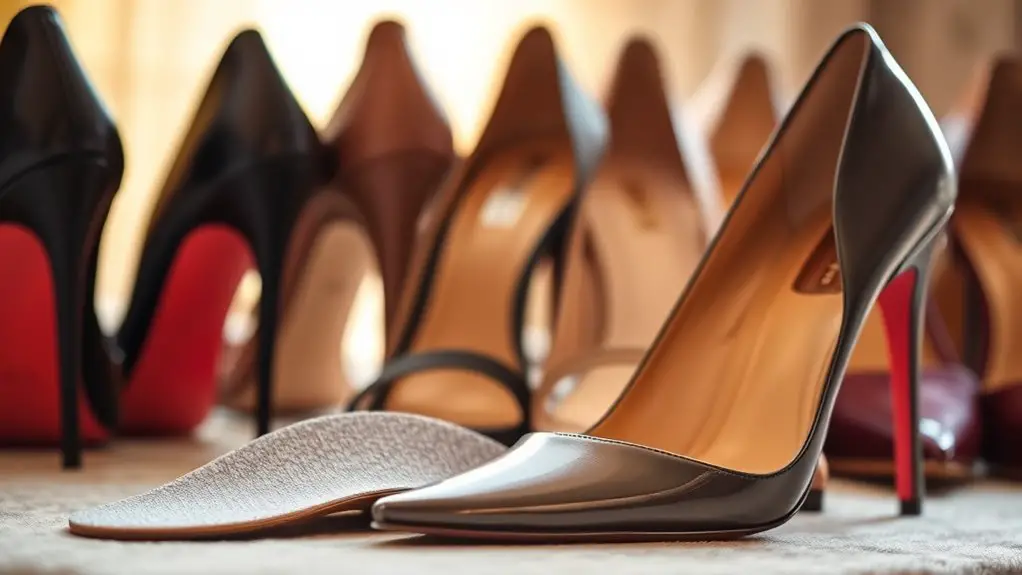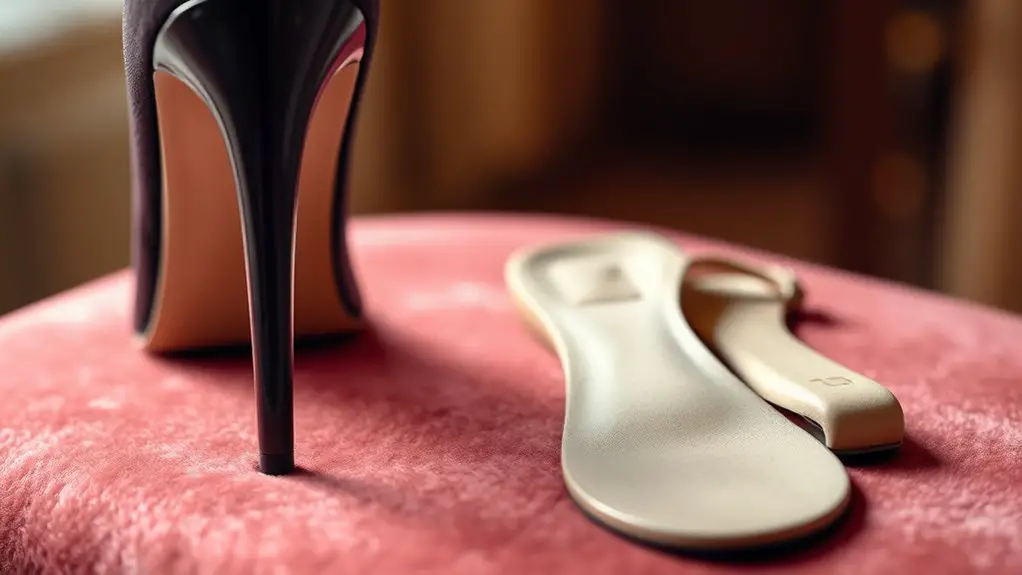Heels fit differently due to variations in brand sizing, heel height, toe box designs, and materials. Each factor affects your comfort and support uniquely. For instance, higher heels may lack arch support, while narrower toe boxes can pinch. To adjust fit, consider using insoles or cushions for added support and stability. Customizing your heels is key to ensuring a perfect fit, and there are effective ways to enhance your overall wearing experience. More insights await you.
Understanding Brand Sizing Variations

When you’re shopping for heels, it’s essential to recognize that brand sizing can vary considerably, which can influence how a pair fits your feet. Size inconsistencies among different brands often result in confusion, as one size in one brand might differ from the same size in another. For example, a size 7 in Brand A may feel tighter compared to a size 7 in Brand B.
Engaging in brand comparisons can help you navigate these discrepancies effectively. It’s wise to consult sizing charts specific to each brand, as they often provide more detailed measurements. Reading customer reviews can also offer insights into fit and comfort across various styles. When you understand these variations, you can make more informed choices, ultimately leading to a better fit. Keep in mind, trying on heels before buying is always the best practice to guarantee you find the right size and style for your feet.
The Impact of Heel Height on Fit
Although heel height is often overlooked, it greatly impacts how a pair of heels fits and feels on your feet. The height can alter not just your posture but also the overall stability and comfort of the shoe. Here’s how heel height affects the fit:
Heel height significantly influences fit, comfort, and posture, making it a crucial factor in choosing the right pair of heels.
- Heel Stability: Taller heels can compromise balance, making it harder to walk comfortably. A lower heel often provides better stability and control.
- Arch Support: Shoes with higher heels may lack adequate arch support, leading to discomfort over time. Proper arch support is essential for maintaining foot health.
- Weight Distribution: The design of the heel influences how your weight is distributed across the foot, affecting pressure points and overall comfort.
When choosing heels, consider how the height aligns with your foot’s natural structure to guarantee a better fit and enhanced comfort.
Exploring Toe Box Design Differences

Since the toe box is the area of the shoe that accommodates the toes, its design plays an important role in overall comfort and fit. Various toe box shapes, such as rounded, pointed, or squared, can greatly affect how your foot feels in a heel. A rounded toe box shape typically provides more space, reducing the risk of cramping, while a pointed shape may lead to discomfort for those with wider feet.
Toe box width is another crucial factor; a narrow width can constrict your toes, causing pain, especially during prolonged wear. Conversely, a wider toe box allows for natural toe splay, enhancing comfort. When selecting heels, it’s essential to take into account both shape and width to guarantee a proper fit. Remember, an ill-fitting toe box can lead to issues like blisters or bunions, so prioritize designs that suit your foot shape for best comfort.
The Role of Material in Comfort
When it comes to heel comfort, the choice of material plays an essential role. Leather typically offers better breathability and temperature control compared to synthetic options, while cushioning and support features can vary greatly between different materials. Understanding these differences will help you select heels that enhance both comfort and functionality.
Leather vs. Synthetic Materials
Choosing the right material for your heels can greatly influence your comfort throughout the day. Leather and synthetic materials each offer unique benefits, impacting how your shoes feel while you wear them.
- Leather Durability: Offers long-lasting wear and molds to your foot shape over time, enhancing comfort.
- Synthetic Flexibility: Generally lighter and more forgiving, allowing for easier movement but may not provide the same support as leather.
- Breathability: Leather tends to be more breathable, while some synthetics can trap heat, affecting overall comfort.
Ultimately, your choice should align with your lifestyle and foot needs. Consider how each material’s properties interact with your daily activities when selecting the perfect heel for ideal comfort.
Cushioning and Support Features
The material of your heels not only influences durability and flexibility but also plays an important role in cushioning and support. Different cushion types, such as memory foam or gel, greatly enhance comfort by conforming to your foot’s shape. This adaptability can alleviate pressure points, which is particularly beneficial for prolonged wear. Additionally, the right arch support is essential for maintaining foot alignment and reducing fatigue. Heels with built-in arch support can prevent discomfort by distributing weight evenly across the foot. When selecting heels, consider the material’s capacity for both cushioning and support, as these features directly impact your overall comfort and foot health. Prioritizing these elements can make a considerable difference in your wearing experience.
Breathability and Temperature Control
Although comfort is often associated with cushioning and support, breathability and temperature control are equally essential for an enjoyable wearing experience. The materials used in heels greatly impact these factors.
Consider the following aspects of breathable fabrics:
- Moisture-Wicking: Fabrics that draw sweat away from your feet help maintain dryness, enhancing comfort throughout the day.
- Ventilation: Materials with perforations or mesh structures allow air circulation, aiding in temperature regulation.
- Thermal Properties: Certain fabrics can adapt to your foot’s temperature, guaranteeing you don’t overheat or feel chilly.
Selecting heels made from breathable fabrics guarantees better temperature regulation, keeping your feet comfortable and reducing fatigue. Prioritizing these features can lead to a more pleasant wearing experience, allowing you to wear your favorite heels longer.
How Foot Shape Influences Fit
Understanding how your foot shape affects fit is essential for finding comfortable heels that provide support and stability. Your arch shape considerably influences the overall comfort; a high arch may require a different heel design than a low arch. Foot width also plays a vital role; narrow or wide feet can change how the shoe conforms to your foot. Toe length must be considered as well, as longer toes may need more space in the toe box to avoid pressure points. Instep height can impact how securely the heel fits, while pronation type determines how your foot rolls during movement, affecting balance. Additionally, heel shape should align with your foot’s natural contours, and foot flexibility can influence how well a heel accommodates your movements. By understanding these factors, you can make informed choices that enhance both comfort and fit in your heels.
Adjusting Fit With Insoles and Cushions

When trying to achieve a better fit in heels, insoles and cushions can be invaluable tools. They help improve your arch support and enhance your overall comfort level. Here are some options to evaluate:
- Arch Support Insoles: These provide targeted support for the arch, reducing strain and discomfort during wear.
- Gel Cushions: Placing gel cushions in the ball of the shoe absorbs shock, helping to alleviate pressure on your feet.
- Heel Grips: These prevent your heel from slipping, ensuring a more secure fit and reducing blisters.
Strategies for Breaking in New Heels
Breaking in new heels can be a challenging task, but with the right strategies, you can make the process smoother and more comfortable. Employing effective breaking techniques is crucial. Start with gradual wear—begin by wearing your heels for short periods at home. This allows your feet to adapt without overwhelming discomfort.
Here are some effective strategies:
| Technique | Description | Duration |
|---|---|---|
| Wear at Home | Start with 30 minutes daily | 1-2 days |
| Use Thick Socks | Wear them with thick socks | 2-3 hours |
| Heat and Stretch | Use a hairdryer to warm the material | 5-10 minutes |
| Walk on Carpet | Practice walking on soft surfaces | 15-30 minutes |
Utilizing these techniques will help alleviate pressure points and guarantee a better fit over time, making your new heels more enjoyable to wear.
Customizing Your Heels for a Perfect Fit
To achieve a perfect fit in your heels, start by accurately measuring your foot size, as this is essential for selecting the right size and style. Additionally, consider using heel inserts to enhance comfort and support, especially if your heels tend to slip or feel loose. Customizing these aspects will greatly improve your overall wearing experience.
Measuring Your Foot Size
While many people assume they know their shoe size, accurately measuring your foot is essential for customizing heels that fit perfectly. Start by measuring both foot length and width measurement. Here’s how to do it:
- Foot Length: Stand on a piece of paper, mark the tip of your longest toe and the back of your heel. Measure the distance between the two points.
- Width Measurement: Using a soft measuring tape, wrap it around the widest part of your foot. Note the circumference.
- Sizing: Compare your measurements to a sizing chart to determine your ideal heel size.
These steps will help you achieve a precise fit, ensuring your heels are comfortable and stylish.
Using Heel Inserts
Heel inserts are a practical solution for enhancing the fit and comfort of your shoes. They can greatly improve the overall experience, especially with various heel types, such as stilettos or block heels. Depending on your foot’s anatomy, you might need inserts that provide specific arch support, helping to alleviate pressure and distribute weight more evenly.
When choosing heel inserts, consider the material and thickness; softer materials often offer more cushioning, while firmer inserts can enhance stability. It’s essential to guarantee the inserts fit snugly within your shoes without causing overcrowding. By customizing your heels with the right inserts, you can achieve a tailored fit that accommodates your unique foot structure, making those stylish heels far more comfortable for extended wear.
When to Seek Professional Shoe Fitting
Wondering when it’s time to seek professional shoe fitting? If you’re experiencing discomfort or fit issues with your heels, it’s essential to get expert help. Professional shoe fitting can provide tailored solutions and enhance your overall comfort. Consider seeking professional advice in the following situations:
If you’re facing discomfort with your heels, professional shoe fitting can provide expert solutions for better comfort and fit.
- Persistent Pain: If you often feel pain in your feet, ankles, or knees after wearing certain heels, it’s time to consult a professional.
- Unusual Foot Shape: If your feet have unique contours or widths that standard sizes don’t accommodate, a fitting can help identify the right shoe for you.
- Frequent Shoe Returns: If you continuously buy and return heels due to sizing concerns, professional assistance can save you time and frustration.
Getting a proper shoe fitting guarantees that you’ll find heels that not only look good but also feel comfortable, allowing you to walk with confidence.
Frequently Asked Questions
Can Heel Fit Vary Based on the Season or Climate?
Did you know that 70% of people experience heel discomfort with seasonal materials? Climate impacts fit as heat expands materials, while cold contracts them. So, it’s essential to contemplate how weather affects your heel comfort.
How Often Should I Replace My Insoles for Optimal Heel Fit?
You should replace your insoles every 6 to 12 months for ideal heel fit. This guarantees insoles longevity and comfort improvement, maintaining proper support and cushioning, which can greatly impact your overall foot health and footwear experience.
Are There Specific Brands Known for Wider or Narrower Shoe Designs?
About 60% of people wear the wrong shoe size. Brand sizing varies widely, with some brands like New Balance offering wider designs, while others, using rigid materials, tend to run narrower. Always check specific sizing charts.
Do Foot Conditions Affect How Heels Fit Over Time?
Yes, foot conditions can greatly affect how heels fit over time. You may need to make heel adjustments to accommodate changes in your foot’s shape or size, ensuring comfort and proper support as conditions evolve.
Can Heel Fit Change With Age or Weight Fluctuations?
Yes, heel fit can change with age-related changes and weight fluctuations. As you age, your foot’s structure may shift, and weight impact can alter your arch and overall foot shape, affecting how heels fit.



